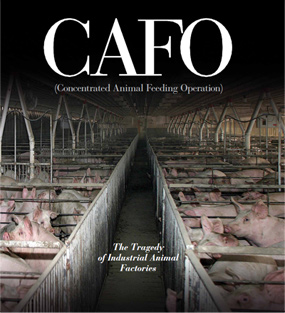
© Cafothebook.org
The retail prices may be low, but they fail to include impacts on human health, the environment, and other shared public assets.
You will ultimately foot a much bigger bill, paying your part of hundreds of billions of dollars in taxpayer subsidies, medical expenses, insurance premiums, declining property values, and mounting cleanup costs.
Lie #2: Industrial Food is EfficientIndustrial food animal producers rely on heavily subsidized agriculture, large infusions of capital, and lax enforcement of regulations. High productivity and domination of market share should not be confused with efficiency. When you measure total cost per unit of production, or even net profit per animal, you find that confinement operations come with hidden costs.
Lie #3: Industrial Food is HealthyIndustrial animal food production heightens the risk of the spread of food-borne illnesses. And it is no coincidence that rates of heart disease, cancer, diabetes, and obesity are at an all-time high. What's more, respiratory diseases and outbreaks of illnesses are increasingly common among CAFO and slaughterhouse workers - and spill over into neighboring communities.
According to AlterNet:
"Food production that is safe for the environment, humane to animals, and sound for workers and communities gives us the best chance for a food system that is safe and healthy for eaters and producers alike."
Source AlterNet October 21, 2010
Comment: For more information about wheat and gluten intolerance read the following articles:
The Dark Side of Wheat - New Perspectives on Celiac Disease and Wheat Intolerance
Opening Pandora's Bread Box: The Critical Role of Wheat Lectin in Human Disease
The Critical Role of Wheat in Human Disease
Gluten: What You Don't Know Might Kill You
The Addictive Opioids in Wheat and Dairy Foods